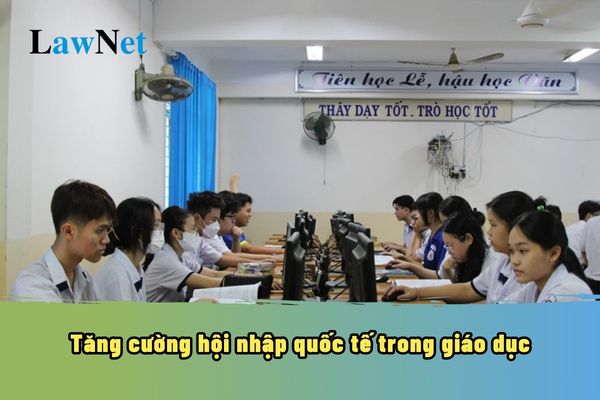Strengthening international integration in education in the academic year 2024 - 2025 in Vietnam
What are regulations on strengthening international integration in education in the academic year 2024-2025 in Vietnam?
Based on Clause 7 of Section 2 of the Plan for tasks and key solutions for the academic year 2024-2025 issued with Decision 2236/QD-BGDDT in 2024, which outlines 12 key tasks and solutions for the academic year 2024-2025, strengthening international integration in education for the academic year 2024-2025 is implemented as follows:
- Further promote international integration in education and training, attract and effectively utilize foreign resources for education and training; attract reputable higher education institutions to establish branches in Vietnam.
- Encourage and facilitate domestic higher education institutions to collaborate with foreign higher education institutions in training, scientific research, form strong research groups, proactively participate in global research and exchange networks; enhance the management of educational institutions with foreign elements and organizations providing study abroad consultancy services.
- Implement training of high-quality human resources abroad funded by the state budget, especially in training doctoral-level lecturers and experts in advanced technical and technological fields; intensify the attraction of international students to study in Vietnam.
- Actively participate in international educational quality assessments that Vietnam has committed to, for education and training at the primary and secondary levels (including SEA-PLM, PISA, TALIS) for the cycle 2024, 2025; encourage Vietnamese higher education institutions to participate in quality assessment programs of prestigious organizations in the region and internationally.
Therefore, strengthening international integration in education for the academic year 2024-2025 is both a task and a key solution for the academic year 2024-2025.

Strengthening international integration in education in the academic year 2024 - 2025 in Vietnam (Image from the Internet)
What are 5 perspectives of the Scheme for international integration in education until 2030 in Vietnam?
Based on Section 1 of Decision 1600/QD-TTg in 2024, the Scheme for international integration in education until 2030 in Vietnam outlines 5 perspectives as follows:
Perspective 1. Foster international integration in education and training in accordance with the viewpoints, guidelines, and orientations of the Communist Party and the State, especially in Resolution No. 29-NQ/TW dated November 4, 2013, of the 8th Central Committee of the XI Term on fundamental and comprehensive renovation of education and training, meeting the requirements of industrialization and modernization in a socialist-oriented market economy under international integration and Conclusion No. 91-KL/TW dated August 12, 2024, of the Politburo on continuing to implement Resolution No. 29-NQ/TW dated November 4, 2013.
Perspective 2. Proactively engage in comprehensive and in-depth international integration in education and training; selectively absorb international experiences to contribute to renewing and improving the quality of Vietnam's education and training; enhance international cultural, academic, and educational cooperation and exchange; elevate Vietnam's international standing and reputation.
Perspective 3. Strengthen cooperation and international integration in education and training with other countries and international partners, especially those with advanced education systems, neighboring countries, strategic partners, comprehensive partners, and traditional friends.
Perspective 4. Promote the diversification and multi-tier cooperation, and investment with foreign partners in education and training; leverage the potentials, strengths, and opportunities to mobilize, attract, and use effectively resources, contributing to increasing the scale and quality of human resources, especially high-quality human resources.
Perspective 5. Boost integration and cooperative training in strategic and pioneering technological fields, contributing to the expansion of the labor market, the development of science and technology, and the promotion of the country's socioeconomic development.
What are the overall objectives of the Scheme for International Integration in Education and Training until 2030 in Vietnam?
Based on Section 2 of Decision 1600/QD-TTg in 2024, the overall objective of the Scheme for International Integration in Education and Training until 2030 is defined as follows:
* General Objective
Enhance international integration in education and training to contribute to improving education quality, training high-quality human resources to serve the objectives of economic and social development, promote public diplomacy, and engage in international cooperation activities in other fields.
* Specific Objectives
- At least 10 administrative units participate in UNESCO's global learning cities network by 2030; strive to have 05 additional provinces/cities with preschools and general education institutions teaching integrated programs with foreign curricula.
- Strive for 100% of general education students to reach foreign language proficiency as specified in the general education curriculum of Foreign Language 1; improve foreign language capabilities and the capacity to teach other subjects in foreign languages for teachers, lecturers, and educational management staff at all levels; gradually introduce English as the second language in schools.
- Over 20% of international joint training programs offer disciplinary courses from foreign educational institutions ranked in the top 500 worldwide; increase the percentage of international students enrolled in Vietnamese degree programs in higher education to 1.5%; increase the total rate of Vietnamese faculty going abroad and foreign faculty coming to teach, research, and conduct academic exchanges annually to 8% of the total Vietnamese faculty.
- Over 80% of higher education institutions have at least 3 joint research projects or cooperative projects with foreign partners annually.
- Over 20% of training programs in Vietnamese higher education institutions meet quality accreditation standards by reputable foreign accreditation organizations.
- Strive to attract an additional 02 branches of reputable foreign higher education institutions in Vietnam.

